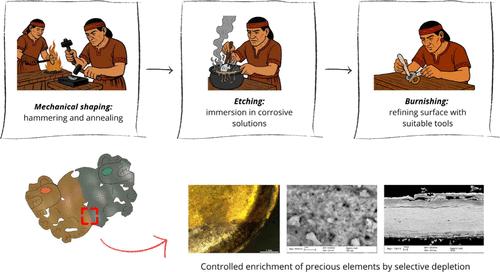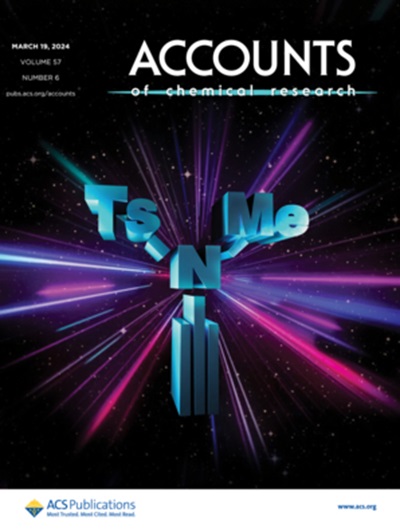Surface Manipulation in Cu- and Ag-Based Pre-Columbian Artifacts
IF 17.7
1区 化学
Q1 CHEMISTRY, MULTIDISCIPLINARY
引用次数: 0
Abstract
Numerous metal artifacts of exceptional historical and artistic value from the Moche civilization (ca. 450 AD) were unearthed in the tomb of the Lady of Cao (El Brujo, Peru). The tomb yielded the tattooed, mummified remains of a young woman, who was approximately 25 years old at the time of her demise. The rich array of artifacts and insignia of power found within the tomb provides compelling evidence of her elevated status in the hierarchical Moche society. Among the artifacts, the gilded objects and intriguing apparently bimetallic nose ornaments, featuring adjacent gold and silver surfaces, are particularly noteworthy. These artifacts reveal the sophisticated craftsmanship of Moche metalworkers, who expertly produced and worked on Cu- and Ag-based alloys. Moche metalworkers, once they worked and shaped the alloys to a thickness of approximately 100–150 μm, in some artifacts meticulously formed localized, uniform, and thin (roughly 3–5 μm thick) gold- and silver-enriched surface layers by employing etching agents. This process involved the selective depletion of copper from Cu-based alloys and, in some regions, the removal of both copper and silver from a Ag–Cu–Au ternary alloy. The presence of epitaxially grown micrometric silver wires, which resemble the elongated architecture of naturally occurring silver curls, supports the hypothesis of a subtractive surface treatment. These findings demonstrate a pioneering, though empirical, capacity to produce specific Cu- and Ag-based alloys and to select suitable materials for surface manipulation. This capability led to the tailored chemical modification of the outermost layers, resulting in a fascinating monometallic or bimetallic appearance likely imbued with religious, symbolic, or shamanic values. It is noteworthy that the creation of such enthralling artistic masterpieces was uniquely enabled by this ability to manipulate matter at the micro- and nanoscale, combined with the goldsmiths’ artistic creativity.

以铜和银为基础的前哥伦布时期文物的表面处理
在秘鲁埃尔布鲁霍(El Brujo)的曹夫人墓中出土了许多具有特殊历史和艺术价值的金属文物,这些文物来自莫切文明(约公元450年)。坟墓里发现了一具年轻女子的木乃伊,她身上有纹身,死亡时大约25岁。在墓中发现的丰富的文物和权力徽章为她在等级分明的莫切社会中的地位提升提供了令人信服的证据。在这些文物中,镀金的物品和引人注目的明显是双金属的鼻饰,以相邻的金和银表面为特征,尤其值得注意。这些文物揭示了莫希金属工人的精湛工艺,他们熟练地生产和加工铜和银基合金。莫切族金属工人在加工和塑造合金厚度约为100-150 μm后,在一些人工制品中,通过使用蚀刻剂精心形成局部、均匀且薄(约3-5 μm厚)的富金和富银表面层。这个过程包括从铜基合金中选择性地耗尽铜,在某些地区,从Ag-Cu-Au三元合金中同时去除铜和银。外延生长的微米银线的存在,类似于自然产生的银卷曲的细长结构,支持了减法表面处理的假设。这些发现证明了一种开创性的,尽管是经验的,生产特定铜基和银基合金的能力,并选择合适的材料进行表面处理。这种能力导致了对最外层的量身定制的化学修饰,从而产生了迷人的单金属或双金属外观,可能充满了宗教,象征或萨满的价值。值得注意的是,创造出如此迷人的艺术杰作,是由于这种在微观和纳米尺度上操纵物质的能力,加上金匠的艺术创造力。
本文章由计算机程序翻译,如有差异,请以英文原文为准。
求助全文
约1分钟内获得全文
求助全文
来源期刊

Accounts of Chemical Research
化学-化学综合
CiteScore
31.40
自引率
1.10%
发文量
312
审稿时长
2 months
期刊介绍:
Accounts of Chemical Research presents short, concise and critical articles offering easy-to-read overviews of basic research and applications in all areas of chemistry and biochemistry. These short reviews focus on research from the author’s own laboratory and are designed to teach the reader about a research project. In addition, Accounts of Chemical Research publishes commentaries that give an informed opinion on a current research problem. Special Issues online are devoted to a single topic of unusual activity and significance.
Accounts of Chemical Research replaces the traditional article abstract with an article "Conspectus." These entries synopsize the research affording the reader a closer look at the content and significance of an article. Through this provision of a more detailed description of the article contents, the Conspectus enhances the article's discoverability by search engines and the exposure for the research.
 求助内容:
求助内容: 应助结果提醒方式:
应助结果提醒方式:


